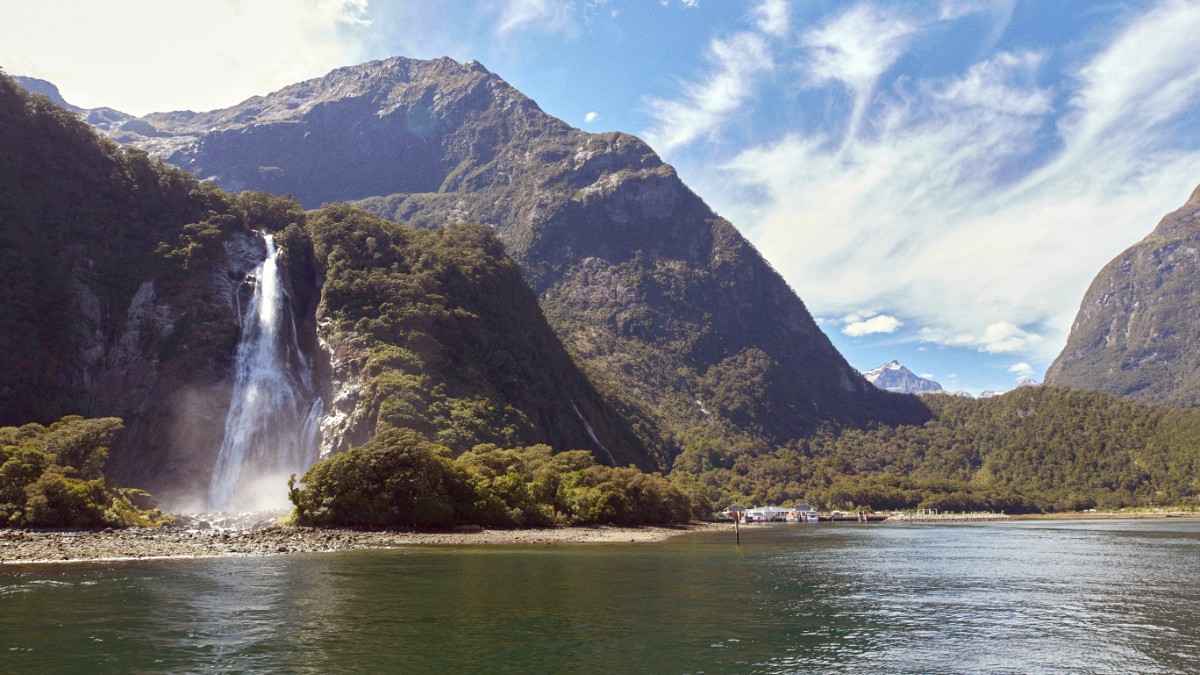
Fiordland And Southland, New Zealand
Summers (Dec-Feb) see average high temperatures around 19°C (66°F), offering comfortable outdoor conditions despite frequent rain. Long daylight hours mark this period. Autumn (Mar-May) brings cooler averages of 16°C (61°F) and more stable weather periods. Winters (Jun-Aug) are the coldest, with highs around 9°C (48°F) and lows around 2°C (36°F). Snowfall transforms peaks, but the Milford Road becomes prone to snow and ice. Spring (Sep-Nov) sees temperatures rise to 14°C (57°F), with increasing rainfall activating spectacular waterfalls. Daylight lengthens significantly. Road conditions early spring can still have snow and avalanche risks.
Regardless of the season, Milford Sound often looks its most impressive during and after rainfall, when hundreds of temporary waterfalls cascade down the cliffs. Proper waterproof gear is always wise.
Rain is a constant companion in Milford Sound. Do not view rain as a deterrent; it makes the fiord's beauty more grand by activating hundreds of temporary waterfalls, transforming the landscape into an even more dynamic spectacle. Preparing for wet weather is important, with waterproof clothing a must-have.
Sandflies are prevalent, so Strong insect repellent is a travel essential. During winter and early spring, the Milford Road is prone to avalanches and rockfalls. Check road status updates frequently.
Peak Season
Warmest weather, longest daylight for activities, all services fully operational.
Highest crowds, peak prices for accommodation and tours, booking well in advance is common.
Shoulder Season
Fewer crowds, stable weather periods, crisp clear days possible, beautiful foliage.
Shorter daylight, cooler temperatures, some services begin reducing frequency.
Low Season
Quieter, dramatic snow-capped peaks, unique moody atmosphere, sometimes cheaper rates.
Milford Road can close due to snow or avalanches, very cold, shortest daylight, reduced service schedules.
Milford Sound cruises run year-round, with each season offering a distinct atmosphere. Rain often makes the cruise experience better by multiplying waterfalls. For warmer weather and longer daylight, summer stands ideal. For a quieter, more dramatic, and snow-capped experience, winter offers unique charm. Kayaking conditions are most stable and comfortable in summer and autumn, with warmer temperatures making paddling more pleasant. Guided kayaking tours operate in nearly all weather with proper gear.
Day hikes along the Milford Road are accessible year-round, but summer and autumn offer the most reliable weather. Winter conditions mean paths may be icy or snowy, needing appropriate footwear. Multi-day Great Walks like the Milford Track officially run from late October to late April, when huts are serviced. Outside this period, tracks are unserviced and can be hazardous. Wildlife, like fur seals and dolphins, are present year-round. Fiordland crested penguins are more observed during their breeding season, typically July to November.
Operates year-round; rain often enhances waterfall displays.
Summer & Autumn offer best conditions; guided tours continue in most weather.
Year-round access; summer/autumn have best weather. Winter paths icy.
Official season Oct-Apr; booking well ahead is common.
Best observed during breeding season (July-Nov).
New Zealand has specific visa and entry requirements that vary based on your nationality and visit purpose. Milford Sound is within New Zealand, so the country's general entry rules apply.
Many countries (e.g., USA, UK, Canada, Australia, EU) participate in a visa waiver program for tourism up to three months. A New Zealand Electronic Travel Authority (NZeTA) and an International Visitor Conservation and Tourism Levy (IVL) are required before travel.
Upon arrival, have the correct documentation ready for immigration for a smooth entry process.
Costs vary based on your travel style, from backpacking to luxury. These estimates (in NZD) are a general idea, but prices fluctuate by season, booking time, and specific choices.
New Zealand is a safe country, but its natural environment presents specific considerations. Preparedness for weather and local conditions makes a visit more enjoyable.
No specific vaccinations are mandatory. Ensure routine vaccinations (MMR, DPT, Polio) are current.
Prevalent biting insects. Wear long clothing, use Strong insect repellent (DEET/Picaridin).
High UV levels. Use High SPF sunscreen, Wide-brimmed hat, and Sunglasses. Seek shade.
Water Safety:
Tap water in Te Anau and Milford Sound Lodge is safe. For remote hiking, consider treating stream water or carrying enough supply.
Hypothermia: Weather changes rapidly. Dress in layers, including waterproof and windproof outer layers. Avoid cotton, which loses insulation when wet.
Always prioritize dry, insulating clothing.
No medical facilities beyond basic first aid at Lodge/Terminal. Transport to Te Anau or further is typical for treatment.
Fiordland Medical Centre. For serious conditions, travel to Invercargill (2.5 hrs) or Queenstown (2 hrs) is possible.
Dial 111 for Police, Fire, or Ambulance (free from any phone). Clear location details are important.
Milford Sound and Te Anau are very safe with extremely low crime rates. Vehicle safety at trailheads and viewpoints remains important.
Comprehensive travel insurance stands highly recommended due to Milford Sound's remote location. Policy coverage should include:
Coverage for doctor visits, hospital stays, and emergency medical treatment, as non-residents usually pay for services.
Critical for Milford Sound. Helicopter evacuation to a major hospital is very expensive without insurance.
Covers unforeseen cancellation/interruption (e.g., illness, family emergency, road closures to Milford Sound).